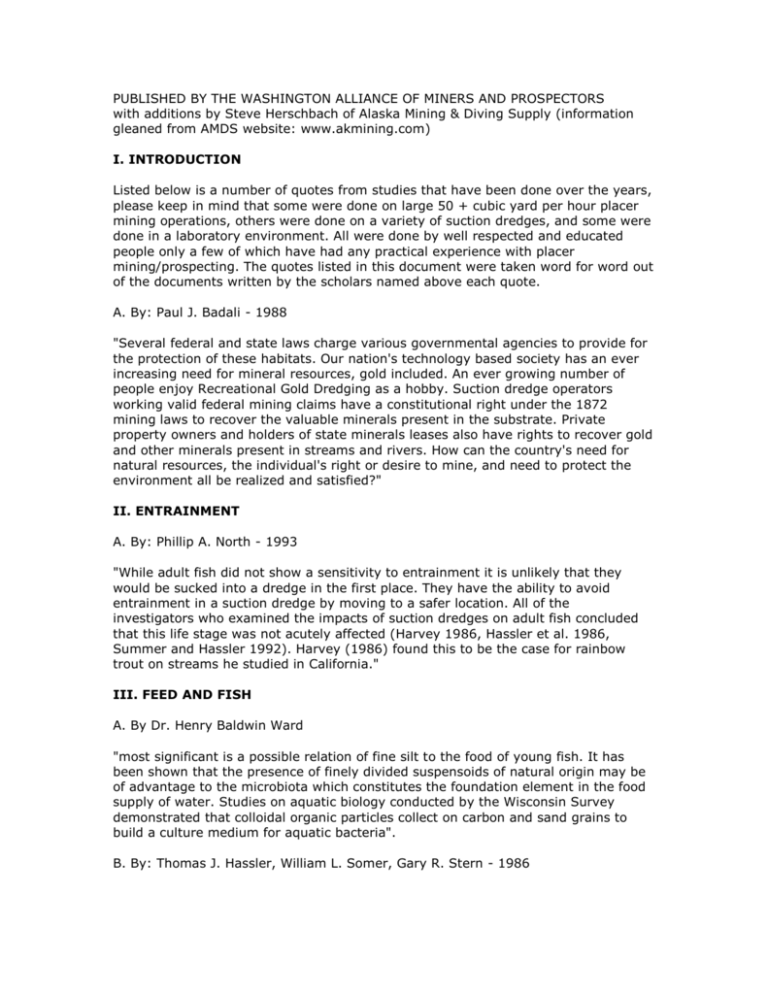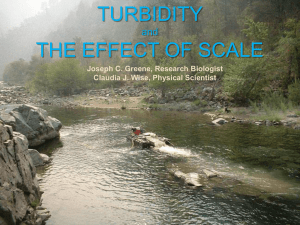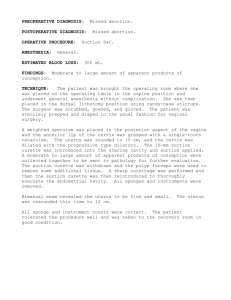PUBLISHED BY THE WASHINGTON ALLIANCE OF MINERS AND
advertisement

PUBLISHED BY THE WASHINGTON ALLIANCE OF MINERS AND PROSPECTORS with additions by Steve Herschbach of Alaska Mining & Diving Supply (information gleaned from AMDS website: www.akmining.com) I. INTRODUCTION Listed below is a number of quotes from studies that have been done over the years, please keep in mind that some were done on large 50 + cubic yard per hour placer mining operations, others were done on a variety of suction dredges, and some were done in a laboratory environment. All were done by well respected and educated people only a few of which have had any practical experience with placer mining/prospecting. The quotes listed in this document were taken word for word out of the documents written by the scholars named above each quote. A. By: Paul J. Badali - 1988 "Several federal and state laws charge various governmental agencies to provide for the protection of these habitats. Our nation's technology based society has an ever increasing need for mineral resources, gold included. An ever growing number of people enjoy Recreational Gold Dredging as a hobby. Suction dredge operators working valid federal mining claims have a constitutional right under the 1872 mining laws to recover the valuable minerals present in the substrate. Private property owners and holders of state minerals leases also have rights to recover gold and other minerals present in streams and rivers. How can the country's need for natural resources, the individual's right or desire to mine, and need to protect the environment all be realized and satisfied?" II. ENTRAINMENT A. By: Phillip A. North - 1993 "While adult fish did not show a sensitivity to entrainment it is unlikely that they would be sucked into a dredge in the first place. They have the ability to avoid entrainment in a suction dredge by moving to a safer location. All of the investigators who examined the impacts of suction dredges on adult fish concluded that this life stage was not acutely affected (Harvey 1986, Hassler et al. 1986, Summer and Hassler 1992). Harvey (1986) found this to be the case for rainbow trout on streams he studied in California." III. FEED AND FISH A. By Dr. Henry Baldwin Ward "most significant is a possible relation of fine silt to the food of young fish. It has been shown that the presence of finely divided suspensoids of natural origin may be of advantage to the microbiota which constitutes the foundation element in the food supply of water. Studies on aquatic biology conducted by the Wisconsin Survey demonstrated that colloidal organic particles collect on carbon and sand grains to build a culture medium for aquatic bacteria". B. By: Thomas J. Hassler, William L. Somer, Gary R. Stern - 1986 "During diving surveys, we observed Salmon gairdneri congregating and selectively feeding on benthic invertebrates displaced by dredging." "Suction dredge mining at levels observed in Canyon Creek probably did not impact steelhead feeding. The mining did not significantly reduce the abundance of aquatic invertebrates (only species composition locally) and steelhead fed opportunistically. In fact , juvenile steelhead were observed feeding on invertebrates that had been entrained in and dislodged by dredge. Thomas (1985) observed cutthroat trout feeding on dislodged invertebrates in the dredge outfall. "However, weight of juvenile steelhead from Canyon Creek was greater than weight from other areas and production (kg/ha) was as good or better than in other areas (table 41)." "Ecological differences between Canyon Creek and BEF were also important in determining colonization of samplers. Overall, the impacts of suction dredge mining to benthic invertebrates at the study site were minimal." C. From: Robert Lewis, Pollution Bioanalyst III - 1962 "Benthos survival is noted in Table 2. Insects with internal extrusions were listed as mortalities. The morality figure of 7.4 percent may be extreme because of confinement in the sack. Many caddis larvae were still attached to rocks after passing through the dredge. All insects except those with extrusions appeared lively and unharmed." "To determine stream distance necessary for insects to settle back to the bottom, a net was placed 15 feet and 25 feet downstream from the outflow. After five minutes at the former distance, Trichoptera, Coleoptera and Diptera were prevalent in the net. Only one Plecoptera was noted. At 25 feet downstream only few insects were caught in the net after five minutes. Underwater inspection with a faceplate indicated that all insects settled within 40 feet. The approximate flow throughout this distance varied from 1 ft./sec. down to 0.5 ft./sec." D. By: Phillip A. North - 1993 "If recolonization is slow the cumulative impacts of suction dredge mining could be significant over a period of seasons. However, in all of the studies on suction dredges that investigated this question the disturbed stream reach was relatively short (on the order of a few tens of meters) and recolonization proved to be rapid. Griffith and Andrews (1981) found that the dredged site was "substantially recolonized" after 38 days. The abundance within orders of invertebrates were the same before and after dredging and "key" taxa were also the same. Harvey (1986) found that recolonization was complete in terms of numbers of insects within 45 days of dredging. Thomas (1985) sampled the site 30 days after dredging and found, again, that colonization was "substantially complete" for most groups. The number of invertebrates colonizing the artificial substrates used by Somer and Hassler (1992) did not increase after the first sampling at two weeks. None of these investigators sampled their study site earlier than the reported time of recolonization. Recolonization may have occurred sooner than the time reported." E. By: The U.S. Environmental Protection Agency - 2001 "The results from Resurrection Creek indicated that there was no difference in the macroinvertebrate community between the mining area and the locations downstream of the mining area in terms of macroinvertebrate density and taxa richness. The sampling was done 35 days after mining had been completed for the season and shows a rapid recovery of the mined areas." IV. FLUSHING FLOWS A. By: Gary R. Stern - 1988 "The autumn, winter and spring peak flows of WY 1985 Canyon Creek were adequate to disperse dredge tailing piles and fill in dredge holes. Less than 9% of the holes and tailings from 1984 mining were visible at the start of the 1985 dredge season. Only two sites from 1984 had clear remnants of holes and tailings in 1985. Both of these were far from the stream's thalweg. At a few sites large cobbles and boulders piled along the shore remained visible one year later. Thomas (1985) reported that piles of cobbles remained along the shore one year later at Gold Creek, Montana, but holes and instream tailings had vanished. Harvey et al. (1982) found virtually no evidence of dredge mining the following year in the American River, California. Most streams with mobile beds and good annual flushing flows should be able to remove the instream pocket and pile creations of small suction dredges, although regulated streams with controlled flows may not." V. SEDIMENT A. By: Dr. Henry Baldwin Ward "All of these tests show .That the amount of colloidal material in the water of the Rouge River and its tributaries below the point at which the run-off of placer mine workings has been added to the stream is to small to produce on the bottom a "blanket" which might affect adversely young fish eggs in the nests if present, or the fish food in the water." "Even below the points at which tributaries entered from areas in which placer mining had gone on at earlier months in the year, no change from normal conditions were observed. The pools sheltered migrating fish; they were also seen in the stream below the dams, and a normal supply of fish food was found at various points visited." These studies were done on commercial placer mining! "The supplementary report of Mr. A. M. Swartley, who aided me in the part of the survey made in September, 1937, is of value in giving the views of a careful and experienced geologist. He confirmed fully statements I had reached in my preliminary report as to the physical conditions found in the Rogue River drainage, and especially the small amount of clay and other material on shores and stream bottoms, in backwaters and otherwise in our examination of the river and its tributaries. He discussed fully the methods of rock disintegration and the transportation and ultimate character of the materials produced. He emphasized the fact that mining debris "is chemically inert, makes no oxygen demand on the stream and therefore takes away from the flowing water nothing which the fish require. This is equally true of this material whether placed in transit by nature or by man since (the products) are alike in nature, come from the same sources and are only being accelerated by man in their journey to the sea." Further he stated:" All these materials entering the streams, whether by natural or human activity, whether coarse or fine, whether traveling on the bottom, in suspension or solution ,are almost altogether inert, suffer little change on their way to the sea, and having reached the end point of chemical change do not rob the water of oxygen which the fish demand, or add to the water toxic agents injurious to fish (fish food or other forms of life)." VI. EFFECTS OF SILT ON FISH A. By: Dr. Henry Baldwin Ward "I have seen among these Alaska rivers in which salmon run and spawn some so heavily loaded with mud that one could not trace the body of an adult salmon ascending the river even when the dorsal fin cut the surface of the water. Yet the fish examined on the spawning grounds just before and just after death showed that the gills had suffered no injuries on the way though the body had met with conspicuous external damage through violent contact with sharp rocks at rapids or falls or along the shore. The examination was made in connection with the study on the cause of death after spawning and all organs were closely inspected. The gills were reported as apparently in perfect condition. Although the object of the investigation was not to determine the effect on the gills of silt loaded waters, still, if any evident injury had been present, it would have been noted. The journey up the Copper and its tributary was long and strenuous; the chance for damage to the salmon from muddy water was certainly large if any damage could be wrought by such conditions, and yet none was observed. Many other similar cases could be cited from printed as well as published records." "Despite their far greater sensitiveness to changes in environment and susceptibility to injury, the young salmon lived heartily in a concentration of sediment which was at its minimum (760 ppm) twice as much as the maximum recorded at Agness (see Table II ). Indeed the average amount of turbidity in Griffin's experiments was ten times the average recorded at Agness. Those who think that normal erosion products will prove injurious to such fish should examine carefully the records in these tables." VII. EFFECT ON SPAWNING GROUNDS A. By: Dr. Henry Baldwin Ward "Normally the fish cover the eggs by a layer of sand or fine gravel; the fresh water carrying oxygen easily penetrates this cover and the young wriggle out after the eggs hatch. A thin, broken layer such as I have already described would not interfere with the permeation of fresh water with oxygen and the development of such eggs as might be present. But I am clear that this is not a true spawning area. As Mr. Joseph Wharton said in an admirable paper on the salmon of the Rogue River, "It is the ambition of all these species of anadromous fish to ascend the river to the highest point attainable before making their spawning beds, seeking the waters that are purest and coldest." This statement is absolutely correct; In difficult streams or when held behind man-made barriers, these fish struggle to the end to make their way upstream and will sacrifice life rather than accept spawning areas in the lower reaches of the river. The urge which drives them on is the basis for the safety of the race. For the straggler or the weakling who may find the achievement of headwaters impossible, an enforced spawning in the lower river is of no significance; the river level varies too widely and its current at full flood is too fierce. Eggs deposited at high water will be exposed and die when the water falls; or if the spawning occurs at a lower water level, the next flood waters will bury the eggs or sweep them away. The suddenness, the violence and the irregularity of the changes in water level of the Rogue are conspicuous in the records of every year." B. By: Thomas J. Hassler, William L. Somer, Gary R. Stern "Dredge tailings are often referred to as good salmonid spawning substrate. In the Trinity River, chinook salmon have been observed spawning in the tailing piles of suction dredges ( E. Miller pers. comm. ). Steelhead in Idaho streams have been reported to spawn in gravels recently disturbed by human activities ( Orcutt et al. 1968 ). In the American River , Prokopovich and Nitzberg ( 1982 ) have shown salmon spawning gravels have mostly originated from old placer mining operations." "Anadramous salmonids held and spawned in Canyon Creek in close proximity to suction dredge activity. During the 1984-1985 spawning season, fall-run chinook salmon, coho salmon and steelhead spawned in areas actively dredged during the 1984 dredge season (fig.). In August 1985, spring-run chinook salmon and summerrun steelhead were holding near areas where suction dredges were being operated (fig. 23). During the 1985 spawning season, fall and spring-run chinook salmon spawned in areas actively dredged during the 1985 dredge season (fig. 24)." C. By: Gary R. Stern - 1988 "Suction dredge mining did not appear to influence the locations of adult anadramous salmonid summer-holding areas. One spring-run chinook salmon was observed 50 m below an operating dredge and a summer-run steelhead was seen at the upper end of a 30 m-long pool while a dredge was operating at the lower end. Seven other adult salmonids were observed within 250 m of an active dredge operation and none appeared to be disturbed by mining activities. During a 1980 diving survey by Freese (1980), an adult spring-run chinook salmon was observed holding at the bottom of an abandoned dredge hole in Canyon Creek and other adult salmonids were found in close proximity to active dredges. No relation between holding areas of spring/summer-run fish and suction dredge mining operations was apparent during this study or in 1980 (L. Freese pers. comm.)." VIII. CHANGES IN THE STREAM BED A. By : Dr. Henry Baldwin Ward "To be sure no one can think rightly of the stream itself as a constant environment. On the contrary it is undergoing continual change. The amount and location of winter's snowfall, the volume and time of seasonal rains, the duration and precise period of regional droughts, and other climatic variations produce variations in water level, in bank erosion, in growth of grasses, underbrush and trees in the drainage basin; thus sudden and often extreme changes in contours of the banks and surrounding country add sediments of different types to its waters and modify the conditions under which the fish it harbors are forced to live." Number one on the list of things that change the shape of the stream bed are DAMS!" B. By: Thomas J. Hassler, William L. Somer, Gary R. Stern - 1986 "However during the suction dredge mining process, a new pool area is created by the cone shaped dredge hole. Dace, suckers and juvenile steelhead were observed feeding and resting in Canyon Creek dredge holes. Freese ( 1980 ) observed a small spring-run chinook salmon holding in a dredge-created pool on Canyon Creek". "The majority of suction dredge operators in canyon creek did not work long periods or disturb large areas of the streamed. Dredging impacts upon the channel geomorphology were confined to the area dredged and the area immediately down stream." "Winter and spring flushing flows filled in dredge holes and dispersed tailing piles." "Coho salmon and steelhead juveniles appeared to rear normally in the creek and were observed using dredge holes in the summer. Steelhead juveniles received the greatest exposure to dredging activity as they rear in Canyon Creek up to three years, but their feeding, growth and production did not seem to be impacted at the current level of dredge activity." C. By: Somer and Hassler - 1992 "The effects of the two dredges on aquatic insects varied with taxa and were site specific. Dredging dislodged insects, and we observed young coho salmon and steelhead feeding on them. The stream underwent major but localized changes. Dredge hole were excavated to a depth of 2 m, and substrate was altered to bedrock and large cobbles-probably a poor habitat for colonization. However, the effects of dredging (at the operating level during the study) on insects and habitat were minor compared with those of bed-load movement due to large stream flows during storms and from snowmelt." D. By: Gary R. Stern - 1988 "Lewis (1962) was the first to investigate the effects of the portable suction gold dredge on the aquatic habitat of fish and benthic invertebrates. He operated a 12.7 cm aperture dredge in Clear Creek, Shasta County, California and found that dredging could improve the intergravel environment for both fish eggs and benthos if the stream was mined in a uniform manner." "If dredge mining regulations were expounded upon and miners were made aware of the instream habitat needs of salmonids, the most serious impacts of suction dredge mining could be reduced. Suction dredgers may even be able to enhance certain areas of the channel for rearing and spawning fish, if some of the limiting factors of a reach of stream are identified (ie. cover, woody debris, low velocity refuges, clean gravels). In Canyon Creek, current CDFG suction dredge regulations eliminate conflicts with salmonid spawning, incubation, and fry emergence by restricting mining to summer months. The 15.24 cm maximum aperture size for dredges is appropriate since stream substrate is large, but larger apertures may be too disruptive in the small channel." E. By: Robert Lewis, Pollution Bioanalyst III Results of Gold Suction Dredge Investigation; "Table 1 lists stand pipe results. The site average indicates an improvement from dredging of 1 p.p.m. in DO and a threefold improvement in permeability and velocity. As indicated above, dredged sand settled within 12 feet of the sluice outflow. This occurrence tends to somewhat nullify removal of sediment, but dredged areas are definitely relieved of compaction. As a gross measure, the standpipe was much easier to drive in the dredged area. As evidenced by photographs the gravel appears much cleaner after dredging. Weighing all factors, dredging can improve the gravel environment for both fish eggs and aquatic insects, especially if the operator mined uniformly in one direction as opposed to a pocket and pile method." F. By: Phillip A. North - 1993 "The four studies that I reviewed from journals subject to peer review consistently found that when certain limitations are placed on suction dredge activity the impacts on the stream ecosystem are local and of short duration." G. By: Bret C. Harvey - 1986 "Fish and invertebrates displayed considerable adaptability to dredging, probably because the streams naturally have substantial seasonal and annual fluctuations (Moyle et al. 1982). These fluctuations, in the form of flushing winter flows, can greatly reduce the long term impact of dredging. Even during the relatively mild winter of 1980/81, high flows still filled the hole created by dredging on NFAR with a sand and gravel mixture and eliminated all sand from the main streamed. After the high flows in winter and spring of 1981/82, no substrate changes caused by dredging in the previous summer were evident on Butte Creek. Saunders and Smith (1965) observed a quick recovery in the trout population after scouring of a heavily silted stream, which, along with the quick temporal recovery of stream insects seen in this study, implies that suction dredging effects could be short-lived on streams where high seasonal flows occur." IX. TEMPERATURE A. By:Thomas J. Hassler, William L. Somer, Gary R. Stern - 1986 "and dredge mining had little, if any, impact on water temperature." X. TURBIDITY A. By: Dr. L. E. Giiffin "When the test ended on Dec. 30, it was found that a much larger proportion of the fish in the sediment -containing trough had survived (56%) than in the clear water trough (10%). There was no noticeable difference in the color of the surviving fish in the two troughs, and the fish which had lived in the muddy water were as large as the survivors from the clear-water trough." "The results of the experiments indicate that young trout and salmon are not directly injured by living for considerable periods of time in water which carries so much soil sediment that it is made extremely muddy and opaque. They also indicate that cutthroat trout and salmon fingerlings can feed and grow apparently well in very muddy water." B. By: Dr. Henry Baldwin Ward "In contrast with all these the experiments of Dr. Griffin have shown that young fish live well up to 30 days in good water mixed with an amount of natural soil materials from two to three times as large as the extreme load of the materials contributed to the Rogue River by maximum conditions produced by placer mining." "All the evidence that has been obtained justifies the conclusion that no present-day contributions of materials produced by bank erosion differ in character or exceed in amount those added periodically by purely natural processes in past times. Splendid runs of salmon and steelhead were established and maintained under truly natural conditions which certainly were on occasion more extreme and violent before man ever came into the picture than they are today. Furthermore, there is good reason to believe that placer mining run-off was larger in amount and more continuous in the early years of that industry when for a time at least greater areas were followed than are employed today." This study was done to study the effects of large scale placer mining operations! XI. WATER QUALITY A. By: Thomas J. Hassler, William L. Somer, Gary R. Stern Water quality was impacted only during the actual operation of a suction dredge. Since a full day of mining by most Canyon Creek operators included only 2 to 4 hours of dredge running time, water quality was impacted for a short time. B. By: Gary R. Stern - 1988 "Turbidity plumes below suction dredges are often markedly visible due to extremely low ambient turbidity levels in mountain streams. The extent of the plume depends on the grain size and volume of the material passing through the dredge. Horizons of silt-laden substrate were disturbed at all dredge sites in Canyon Creek and created highly visible turbidity plumes. " "Although distinct to even the most casual observer, dredge plumes in Canyon Creek were probably of little direct consequence to fish and invertebrates. Suspended sediment concentrations of 20,000 to 100,000 mg/l which impact fish feeding and respiration (Cordone and Kelly 1961) greatly exceed the highest level of 274 mg/l measured in Canyon Creek. In general, dredge turbidity plumes were highly localized and occurred during midday which is not a peak feeding period for steelhead (Moyle 1976). Laboratory studies by Sigler et al. (1984) found that steelhead and coho salmon preferred to stay in channels with clear water, and turbidities as little as 25 NTU's caused a reduction in fish growth. In contrast to Sigler's results, young steelhead in Canyon Creek appeared to seek out dredge turbidity plumes to feed upon dislodged invertebrates even though clear flowing water was available nearby." C. By: Phillip A. North - 1993 "Most water quality studies of the effects of suction gold dredges on streams have focused on turbidity and suspended sediments. These studies have, with some exceptions, largely found that water quality is impacted for a distance downstream of the dredge ranging from a few meters to 30 meters." "However, Huber and Blanchet (1992) found no evidence of cumulative impacts of mining on water quality in streams of the Chugach National Forest in Alaska. They monitored streams in the Forest over a period of three years and found no noticeable impact to water quality associated with suction dredges. All of the studies that I surveyed came to the same conclusion: suction gold dredging had localized and short term impacts. Caveats must be taken into account when coming to this conclusion: All of these studies, except one involved small dredges, 6 inches or less. The one study that involved a larger dredge reported only a small amount of data. Five water samples were taken 500 feet below a six inch dredge and one sample was taken 500 feet below an 11 inch dredge." D. By: The U.S. Environmental Protection Agency - 2001 "In the 1997 permit, EPA defined a small suction dredge as those with nozzles less than or equal to four inches. EPA is proposing to redefine the small suction dredge range as less than or equal to six inches. Information provided in EPA’s suction dredge study and the United States Geological Survey (USGS) study support the conclusion that there are local but short term effects on both water quality and macroinvertebrate communities in the mining areas. On the Fortymile River, dredges larger than those proposed under this GP showed that turbidity was reduced to background levels within 250 feet. It is expected that small dredges would have even less impact on the downstream receiving water quality." XII. REFERENCES Badali, Paul J., 1988, Prepared Statement to Sate of Idaho, Department of Water Resources, Recreational Dredging Seminar on February 3, 1988. Harvey, Bret C., 1986, Effects of suction dredging on fish and invertebrates in two California streams. North American Journal of Fisheries Management 6:401-409. Hassler, Thomas J., Somer, William L., Stern, Gary R., 1986, Impacts of Suction Dredge Mining on Anadramous Fish, Invertebrates and Habitat in Canyon Creek, California. California Cooperative Fishery Research Unit, U.S. Fish and Wildlife Service, Humbolt State University, Cooperative Agreement No. 14-16-0009-1547, Work Order No. 2, Final Report. Huber, C. and D. Blanchet, 1992, Water quality cumulative effects of placer mining on the Chugach National Forest, Kenai Peninsula, 1988-1990. U.S. Forest Service, Chugach National Forest, Alaska Region. 74 pages. Lewis, Robert Pollution Bioanalyst III, 1962, Results of Gold Suction Dredge Investigation. Memorandum of September 17, 1962. California Department of Fish and Game. Sacramento, California, 7 pp. North, Phillip A., 1993, A Review of the Regulations and Literature Regarding the Environmental Impacts of Suction Gold Dredges. U.S. Environmental Protection Agency, Region 10, Alaska Operations Office. Somer, W. L., and Hassler, T. J., 1992, Effects of suction-dredge gold mining on benthic invertebrates in Northern California Stream. North American Journal of Fisheries Management 12:244-252. Stern, Gary R., 1988, Effects of suction dredge mining on anadramous salmonid habitat in Canyon Creek, Trinity County, California. M. S. Thesis, Humbolt State University, Arcata, California, 80 pp. U.S. Environmental Protection Agency, 2001, Fact Sheet NPDES Permit AKG-375000, U.S. Environmental Protection Agency, Region 10, Alaska Operations Office, 16 pp. The quotes listed in this document were taken word for word out of the documents written by the scholars named above each quote. This information was compiled with the intent to inform and educate, so the true facts can be a part of the process in the rule/regulation making pertaining to small scale placer mineral/metal mining and prospecting in our rivers and streams. With special thanks to the Washington Alliance of Miners and Prospectors and Jerry Hobbs. Frank Ames - Spring 1995 Note on DR. HENRY BALDWIN WARD Dr. Henry Baldwin Ward was born into a family of highly regarded scientists. His father, Richard Halsted Ward, was a noted Microscopist who made many advances and inventions in his field. His Aunt, Anna Lydia Ward, in 1886, traveled farther North than, up to that date, any other American woman. Her study of the Eskimos in Northern Labrador formed the basis of an illustrated lecture tour that she gave throughout the country. She was also the author of a number of books on poetry and prose. With this kind of background it is no wonder that Henry himself became a scientist of great renown. Today, the highest award given in the field of parasitology is the "Henry Baldwin Ward" medal. Henry may also be thought of as one of America's first conservationists. The following biography is a reprint from "The Dictionary of American Biography," Supplement Three, 1941-1945; pages 802-803; Charles Scribner's Sons, Inc. New York, 1973; Edward T. Jones, Editor. WARD, HENRY BALDWIN (Mar. 4, 1865-Nov. 30, 1945), zoologist and parasitologist, was born in Troy, N. Y., one of four children and the older of the two sons of Richard Halsted Ward, physician and microscopist, and Charlotte Allen (Baldwin) Ward. Both parents were natives of Bloomfield, N. J. Henry B. Ward attended the public schools of Troy and Williams College (his father's alma mater), from which he graduated, A. B., in 1885. After three years of teaching science in the Troy high school, he went to Europe in 1888 for graduate study in zoology, and for two years attended the universities of Göttengen, Freiburg, and Leipzig, spending the vacation periods at the marine laboratories of Naples, Ville-Franche-sur-Mer, and Helgoland. He was particularly influenced by Prof. Rudolgh Leuckart of Leipzig, an authority on the invertebrates and founder of the celebrated laboratory of parasitology. At Leipzig, Ward conceived the ambition to found a similar laboratory in the United States. Upon his return in 1890, he entered the graduate school of Harvard University, where he received the Ph. D. degree in 1892, with a dissertation on the marine nematomorph Nectomnema agile, Verrill, a species he had observed at Naples. Ward was appointed instructor in zoology at the University of Michigan in 1892 but moved after a year to the University of Nebraska, at first as associate professor, from 1896 as professor. While at Nebraska he published a series of papers on the parasites of man and discovered the presence in the United States of the human lung fluke, Paragonimus. He played a major role in developing a two-year premedical course and in 1902 became the first dean of the University of Nebraska College of Medicine, newly established at Lincoln in affiliation with the Omaha Medical College. In 1909, however, plans were made to move the Lincoln unit to the Omaha campus. When it became clear that, because of rivalries between the two medical faculties, Ward would not be retained as dean after the move, he resigned. That fall he went to the University of Illinois as head of the department of zoology, a position he was to occupy with distinction until his retirement in 1933. In addition to teaching zoology at the undergraduate level, he established one of the first research laboratories in the United States to offer graduate work in parasitology. The large number of students who received the Ph. D. under his supervision later made significant contributions to the growth of this science. To provide an outlet for publishing the results of such research, he inaugurated in 1914, with the assistance of his colleagues Stephen A. Forbes and William Trelease, the series of Illinois Biological Monographs. That same year he also founded the Journal of Parasitology, the first American publication devoted to the field; he continued to edit the journal until 1932, when he presented it to the American Society of Parasitologists to become its official organ. Ward's research reflected in part his love of the outdoors. He early began biological research on the Great Lakes, at first for the Michigan Fish Commission. For many years, beginning in 1906, he conducted summer field investigations of the Alaska and Pacific salmon. Besides his papers on parasites, which dealt with such subjects as parasites of the human eye, the relations of animal parasites to disease, and the spread of fish tapeworm, he was the co-author, with George Chandler Whipple, of Fresh-Water Biology (1918), long a standard work. An active member of the Izaak Walton League of America, of which he was president, 1928-30, and of the National Wild Life Federation, Ward was deeply concerned with national problems of wildlife conservation and the pollution of streams. Ward belonged to a large number of scientific societies and was a leader of many, including the American Microscopical Society (president, 1905), the American Society of Zoologists (president 1912-1914), and the American Society of Parasitologists, of which he was the first president when it was founded in 1925. He contributed significantly to the development of the American Association for the Advancement of Science, as the secretary of Section F (zoology) in 1900, general secretary (1902), vice-president (1905), and permanent secretary (1933-37); and the scientific honor society, Sigma Xi, as secretary (1904-1921) and president (1922-23). Ward was influential also in university affairs. At Illinois he worked closely with President Edmund J. James; articulate and well-spoken, he was particularly effective on faculty committees. He received honorary doctorates from the universities of Cincinnati (1920), Oregon (1932), and Nebraska (1945) and from Williams College (1921). Ward was a handsome, vigorous man, somewhat above average height. Aristocratic, autocratic, ambitious, and enthusiastic, he demanded excellence of himself and of others. On Sept. 11, 1894, he married Harriet Cecilia Blair of Chicago, who was teaching at the music school of the University of Nebraska. They had two daughters, Cecilia Blair and Charlotte Baldwin. Ward was a member of the Presbyterian Church. He died in Urbana, Ill., of a heart attack in his eighty-first year, and was buried there in Mount Hope Cemetery. Sometimes called the "Father of American Parasitology," he was to America what Leuckart had been to Germany.








